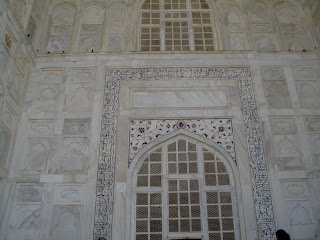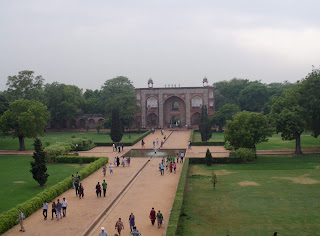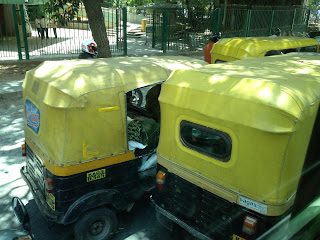I don't think that words or even pictures can do the Taj Mahal justice. My World History book has a picture of the Taj Mahal on the cover and I always thought emm, big white building. But it is truly awe inspiring. It isn't merely white, it is full of color.
We unloaded our bags of food, pens, and gum before we went to buy our tickets. We were all given bottles of water and shoe coverings to wear in the Taj Mahal. We then board electric buses that take us closer to the entrance gate. We are searched not only for weapons but pens and food that could damage the building. As I left security I looked up and there were monkeys running around on the roof of the building.
 As we walked up the path we stop at one of the gates. I could have stayed at the gate looking at it for some time but then we walked through and you are in front of the Taj Mahal. It is so perfect that when you look at it from a distance it doesn't look real. I kept looking at it almost afraid to go any closer because I thought that it would vanish or it would look horrible close up.
As we walked up the path we stop at one of the gates. I could have stayed at the gate looking at it for some time but then we walked through and you are in front of the Taj Mahal. It is so perfect that when you look at it from a distance it doesn't look real. I kept looking at it almost afraid to go any closer because I thought that it would vanish or it would look horrible close up.
I then looked at the surrounding gardens. Like all Muslem architecture and gardens they were perfectly symmetrical. I kept wondering how in the world did they get the gardens that perfect. As I walked through the gardens I kept getting closer to the Taj and the beauty didn't diminish. It only got stronger because the closer that I got the more colors and designs I could see.
As you approach the steps leading up to the Taj Mahal you have two choices either remove your shoes or put the shoe coverings over your shoes. Many of the locals stored their shoes in the shoe racks to the side. As I balanced trying to slide the shoe coverings over my sandals I debated whether or not to go barefoot. I thought even though it was still morning, this is white marble out in the hot sun and it is well over 90 F. I thought that I might fry my feet if I went barefoot so I opted to wear the shoe coverings which were extremely hot.
This building, according to the stories, was built as a monument of love for the death of a beloved wife. The cynic also might say that it was a way to show off the wealth and talents of an empire. The reality is probably somewhere between those extremes or a combination of the two.
The Taj Mahal was built as a mausoleum by Shah Jahan for his favorite wife Mumtaz Mahal after she died giving birth to their fourteenth child. He imported workers from all over his empire to create the building and grounds. It took more than twenty years to build and Shah Jahan never got to see his creation up close. His youngest son killed his older sons and imprisoned Shah Jahan.
There are floral inlays and calligraphy panel covering the surfaces. They are made by cutting out pieces of marble and inlaying different types of precious and semi-precious stones. As beautiful as they are on the outside, this work is even more intricate inside the Taj Mahal. Unfortunately we were not allowed to take pictures inside.
The descendants of the workers who created the inlays still live and work in Agra. They do repair work on the inlayed stones of the Taj Mahal and they create tables and other works of art. We got to see them carving the marble and cutting the stones that would create the different patterns. The more elaborate the design, the more expensive the price. I did not buy anything because my budget cannot afford my taste.
 This was the perfect end to the trip. It is amazing how much history and culture I learned that I can share with my classes. I have also created new friendships. The more I think about this trip, the more that I realize that I have learned not just about India but about my own understanding of the world and how things are interconnected.
This was the perfect end to the trip. It is amazing how much history and culture I learned that I can share with my classes. I have also created new friendships. The more I think about this trip, the more that I realize that I have learned not just about India but about my own understanding of the world and how things are interconnected.
 |
| The Taj Mahal |
We unloaded our bags of food, pens, and gum before we went to buy our tickets. We were all given bottles of water and shoe coverings to wear in the Taj Mahal. We then board electric buses that take us closer to the entrance gate. We are searched not only for weapons but pens and food that could damage the building. As I left security I looked up and there were monkeys running around on the roof of the building.
 As we walked up the path we stop at one of the gates. I could have stayed at the gate looking at it for some time but then we walked through and you are in front of the Taj Mahal. It is so perfect that when you look at it from a distance it doesn't look real. I kept looking at it almost afraid to go any closer because I thought that it would vanish or it would look horrible close up.
As we walked up the path we stop at one of the gates. I could have stayed at the gate looking at it for some time but then we walked through and you are in front of the Taj Mahal. It is so perfect that when you look at it from a distance it doesn't look real. I kept looking at it almost afraid to go any closer because I thought that it would vanish or it would look horrible close up.I then looked at the surrounding gardens. Like all Muslem architecture and gardens they were perfectly symmetrical. I kept wondering how in the world did they get the gardens that perfect. As I walked through the gardens I kept getting closer to the Taj and the beauty didn't diminish. It only got stronger because the closer that I got the more colors and designs I could see.
 |
| Floral inlay |
This building, according to the stories, was built as a monument of love for the death of a beloved wife. The cynic also might say that it was a way to show off the wealth and talents of an empire. The reality is probably somewhere between those extremes or a combination of the two.
 |
| Calligraphy, inlays, and carvings around the window |
There are floral inlays and calligraphy panel covering the surfaces. They are made by cutting out pieces of marble and inlaying different types of precious and semi-precious stones. As beautiful as they are on the outside, this work is even more intricate inside the Taj Mahal. Unfortunately we were not allowed to take pictures inside.
The descendants of the workers who created the inlays still live and work in Agra. They do repair work on the inlayed stones of the Taj Mahal and they create tables and other works of art. We got to see them carving the marble and cutting the stones that would create the different patterns. The more elaborate the design, the more expensive the price. I did not buy anything because my budget cannot afford my taste.
 This was the perfect end to the trip. It is amazing how much history and culture I learned that I can share with my classes. I have also created new friendships. The more I think about this trip, the more that I realize that I have learned not just about India but about my own understanding of the world and how things are interconnected.
This was the perfect end to the trip. It is amazing how much history and culture I learned that I can share with my classes. I have also created new friendships. The more I think about this trip, the more that I realize that I have learned not just about India but about my own understanding of the world and how things are interconnected.























